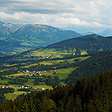GÖTTWEIG ABBEY - KREMS
Baroque Monastery in the Wachau Valley
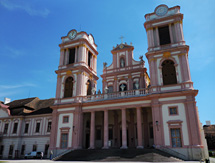 The Göttweig Abbey is an impressive edifice in a beautiful but solitary spot, standing on a mountainside overlooking the wine vineyard covered Wachau Valley of the Danube River on the northern border of Austria, designated as a UNESCO World Heritage area. The Gottweig Abbey (Stift Göttweig) stands as a magnificent example of Baroque architecture, with an Abbot’s palace and an active monastery all rolled into one. Today it seems far from hectic modern civilization in an unspoiled landscape. The Wachau Valley rivals the Middle Rhine region for its castle ruins and vernal landscapes where Danube cruise boats ply the turns of the river between Passau and Vienna. A popular tourist area for its bike trail and wine growing, the Wachau once formed the limit (limes) of the Roman Empire along the southern bank of the Danube. In the middle-ages, King Richard I, the Lionheart, was held for ransom on his return from the Third Crusade at the Castle of Durnstein, now one of the ruins (see Castle Durnstein Richard Lionheart).
The Göttweig Abbey is an impressive edifice in a beautiful but solitary spot, standing on a mountainside overlooking the wine vineyard covered Wachau Valley of the Danube River on the northern border of Austria, designated as a UNESCO World Heritage area. The Gottweig Abbey (Stift Göttweig) stands as a magnificent example of Baroque architecture, with an Abbot’s palace and an active monastery all rolled into one. Today it seems far from hectic modern civilization in an unspoiled landscape. The Wachau Valley rivals the Middle Rhine region for its castle ruins and vernal landscapes where Danube cruise boats ply the turns of the river between Passau and Vienna. A popular tourist area for its bike trail and wine growing, the Wachau once formed the limit (limes) of the Roman Empire along the southern bank of the Danube. In the middle-ages, King Richard I, the Lionheart, was held for ransom on his return from the Third Crusade at the Castle of Durnstein, now one of the ruins (see Castle Durnstein Richard Lionheart).
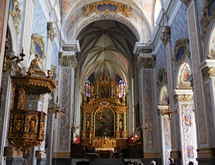 The Abbey of Göttweig (meaning simply Way of God) was founded in 1083 by “the Blessed” Altmann of Passau as the Bishop of Passau known for his founding of monasteries and considered a saint, but not officially canonized and buried at the Abbey. The abbey became a Benedictine Monastery in 1094 by permission of Pope Urban II and from 1094 to 1114 Göttweig became famous for its monastic school and its library, known as a seat of learning. In the late middle-ages between the 15th and 16th centuries, the abbey declined in importance. By 1556, the monastery had no abbot and in 1564 the last resident monk left and turned out the light. A new abbot was sent by the Emperor to reestablish the abbey in 1580 and stave off the effects of the Reformation. Over the next 150 years the monastery was rebuilt and burned down twice.
The Abbey of Göttweig (meaning simply Way of God) was founded in 1083 by “the Blessed” Altmann of Passau as the Bishop of Passau known for his founding of monasteries and considered a saint, but not officially canonized and buried at the Abbey. The abbey became a Benedictine Monastery in 1094 by permission of Pope Urban II and from 1094 to 1114 Göttweig became famous for its monastic school and its library, known as a seat of learning. In the late middle-ages between the 15th and 16th centuries, the abbey declined in importance. By 1556, the monastery had no abbot and in 1564 the last resident monk left and turned out the light. A new abbot was sent by the Emperor to reestablish the abbey in 1580 and stave off the effects of the Reformation. Over the next 150 years the monastery was rebuilt and burned down twice.
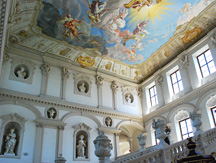 In 1718, after the monastery burnt down for the second time, a plan for reconstruction on a grander imperial scale was commissioned by the ambitious Abbot Gottfried Bessel. With designs by Habsburg Imperial Court Architect Johann Lucas von Hildebrandt and inspired by the Escorial Palace of the King of Spain in Madrid, the Göttweig Abbey took on its palatial form. Rooms of sumptuous living quarters suitable for royalty can be found in the residential wing and one of the masterpieces of the Baroque age of architecture is the imperial staircase (Kaiserstiege), with a fresco by Paul Troger, depicting the Holy Roman Emperor Charles VI in the form of the Greek God Apollo, riding bare-chested in his sun chariot wearing his powdered wig!
In 1718, after the monastery burnt down for the second time, a plan for reconstruction on a grander imperial scale was commissioned by the ambitious Abbot Gottfried Bessel. With designs by Habsburg Imperial Court Architect Johann Lucas von Hildebrandt and inspired by the Escorial Palace of the King of Spain in Madrid, the Göttweig Abbey took on its palatial form. Rooms of sumptuous living quarters suitable for royalty can be found in the residential wing and one of the masterpieces of the Baroque age of architecture is the imperial staircase (Kaiserstiege), with a fresco by Paul Troger, depicting the Holy Roman Emperor Charles VI in the form of the Greek God Apollo, riding bare-chested in his sun chariot wearing his powdered wig!
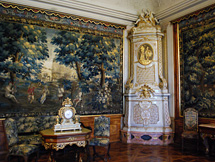 The Baroque abbey is still an active church with services in surroundings of gold gilt and rich art. Several parts of the medieval buildings remain, including the “Old Castle”, the crypt and the medieval church choir, dating from as early as 1072. The abbey library holds 130,000 books and illustrated manuscripts, forming an important collection of religious engravings, coins, antiquities and musical manuscripts which managed to survive the ravages of the Second World War virtually untouched. A permanent exhibit of “the monastic life” illustrates the lives of the Göttweiger monks and the wine estate of the Göttweig Monastery dates back to 1083 and is one of the oldest in Austria, with vineyards in the Wachau and the Krems valley.
The Baroque abbey is still an active church with services in surroundings of gold gilt and rich art. Several parts of the medieval buildings remain, including the “Old Castle”, the crypt and the medieval church choir, dating from as early as 1072. The abbey library holds 130,000 books and illustrated manuscripts, forming an important collection of religious engravings, coins, antiquities and musical manuscripts which managed to survive the ravages of the Second World War virtually untouched. A permanent exhibit of “the monastic life” illustrates the lives of the Göttweiger monks and the wine estate of the Göttweig Monastery dates back to 1083 and is one of the oldest in Austria, with vineyards in the Wachau and the Krems valley.
Visiting Göttweig Abbey
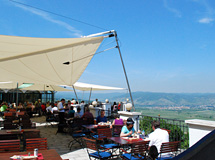 The Abbey Museum is open from March through October with unguided sight-seeing from 10 am to 6 pm. The Abbey Restaurant offers terrace dining with beautiful views overlooking the valley for a short visit. The monastery offers accommodation for guests from May to October with the "guest in the monastery" program which allows time to take in the unique atmosphere of the Göttweig mountain and an opportunity to participate in choral prayers of the monks. Bed and breakfast type of stays are offered through outside services. By car the abbey is about 40 minutes from Vienna or 2 hours from Salzburg off the AI motorway route at the St. Pölten Junction. © Bargain
Travel Europe
The Abbey Museum is open from March through October with unguided sight-seeing from 10 am to 6 pm. The Abbey Restaurant offers terrace dining with beautiful views overlooking the valley for a short visit. The monastery offers accommodation for guests from May to October with the "guest in the monastery" program which allows time to take in the unique atmosphere of the Göttweig mountain and an opportunity to participate in choral prayers of the monks. Bed and breakfast type of stays are offered through outside services. By car the abbey is about 40 minutes from Vienna or 2 hours from Salzburg off the AI motorway route at the St. Pölten Junction. © Bargain
Travel Europe
Find best hotel and travel deals in Wachau Valley on Trip Advisor
Web Info
Göttweig Abbey
These articles are copyrighted and the sole property of Bargain Travel Europe and WLPV, LLC. and may not be copied or reprinted without permission.
SEE ALSO:
TREASURES OF ST STEPHENS CATHEDRAL
ST PETERS CHURCH BAROQUE GEM OF LEOPOLD I
SMALLEST BAROQUE CHURCH - BREGENZ
HOTEL RICHARD LOWERHERZ - DURNSTEIN

